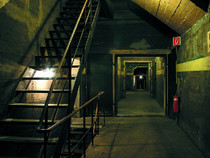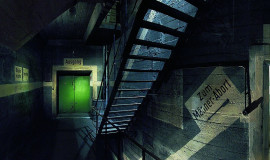History of Photoluminescence
As part of the tour for these rooms they turn out the light to demonstrate the glow of the luminescent paint around the doors, walls and escape exits, used to prevent panic during blackouts. They state that “It’s not as strong as it was in 1941,”. “Apparently you could read a newspaper for 45 mins by this light back then” but it still glows now some 72 years later.
Photoluminescent materials were originally designed to complement existing emergency lighting systems but continuous improvements in luminance performance mean that in many circumstances high quality photoluminescent products can replace electrical/battery emergency lighting altogether (see CIBSE Fire Guide E 3rd Edition). They can be sited at waist or skirting level so they can still function if the ceiling lights become obscured and covered by smoke. Similarly, life saving appliances and fire fighting equipment become more visible and are easily located in an emergency. Some electrical emergency lighting can take up to 15 seconds to activate. In these instances, photoluminescence can be a lifesaver, especially if you happen to be on a staircase at the time,
A choice has existed between electrically powered and photoluminescent pathway marking since the 1980s. On cruise ships, owners generally decided to install electrically powered pathway marking using strips of LEDs in passenger areas and photoluminescent pathway marking in crew areas, however due to reliability and maintenance costs photoluminescence has found it's way into passenger areas as well. On trains, photoluminescent pathway marking has been the predominant choice across the world. For aircrafts, photoluminescent pathway marking is preferable given its lower weight and higher reliability. In buildings, the few recent regulations requiring pathway marking have generally limited it to photoluminescent technology.
The main advantage to electrically powered pathway marking is that it can be brighter than photoluminescent technology depending on the grade and amount of photolumiscent product used. However, that brightness is dependent on a battery, wiring and connections, which may fail to operate. Photoluminescent technology cannot fail to emit light once it has been “charged” by an ambient light source.
This is not to say that photoluminescent technology is infallible. It must be exposed to ambient light of a minimum intensity and type for a set period of time to absorb enough energy (typically 15 minutes for a full charge at light levels as low as 21 lux), to emit useful light. Those advocating against the use of photoluminescent pathway marking worry that the system will not be properly charged and functional if an emergency occurs immediately after occupants enter a building. However, electrically powered exit signs and emergency lighting pose a similar risk when recharging their batteries, because they may not yet be fully operational at that time. It should also be noted that smoke rises and lights positioned at ceiling level will diminish to the point of being obscured completely, low level way guidance will automatically come into operation when darkened conditions prevail regardless of power failure or not.
Another potential point of failure in the past was the carrier. Photoluminescent pathway marking was predominantly manufactured by casting or molding the pigment into a carrier, generally plastic. These carriers were susceptible to degradation from ultraviolet radiation or moisture, where there is this possibility the use of aluminium carriers are now employed.
1980s- Electrically powered pathway marking required on commercial aircraft by the Federal Aviation Administration (FAA).
1984 - Haunted House fire at Great Adventure Amusement Park kills eight. The Life Safety Code (NFPA 101) is subsequently modified to require directional exit marking in special amusement buildings.
1990 - Scandinavian Star cruise ship fire kills 158. The International Maritime Organization (IMO) passes a law in 1993 requiring pathway marking on all cruise ships and ferries by October 1997.
1993 - Bombing of World Trade Center kills six and injures more than 1,000. The bomb knocks out normal and emergency lighting, greatly complicating egress. The Port Authority of New York and New Jersey subsequently installs photoluminescent pathway marking in the stairs.
1997 - With the emergence of a brighter pigment, the FAA allows the use of photoluminescent pathway marking in addition to electrically powered systems on commercial aircraft.
1999 - Following a deadly train wreck, the American Public Transit Association releases guidelines for installing pathway marking on commuter trains by 2006.
1999 - Canadian National Research Council releases a study comparing evacuation of a high-rise building using photoluminescent pathway marking in some stairwells and traditional emergency lighting in others. Study finds that occupant egress speeds are comparable even though occupants were unfamiliar with pathway marking technology.
2000 - NFPA 101 is modified to include the use of photoluminescent exit signs.
2001 - September 11th attacks result in collapse of World Trade Center towers. Survivors report that the photoluminescent pathway marking assisted them in their escape. In the Pentagon, occupants report difficulty in escaping after Flight 77 slammed into the building. Reconstruction of the Pentagon includes the addition of photoluminescent pathway marking in corridors and stairwells.
2003 - The United Nations voluntarily installs photoluminescent pathway marking in corridors and stairwells of its New York City complex.
2004 - Citing the use of photoluminescent pathway marking on September 11th, New York City passes Local Law 26, which includes a requirement for photoluminescent pathway marking in all high-rise office building stairs by July 2006.
2007 - Canadian National Research Council releases a second study of evacuation of a high-rise building comparing photoluminescent pathway marking to traditional emergency lighting. Study suggests that photoluminescent pathway marking may be an acceptable alternative to emergency lighting.
2007 - New Zealand modifies its building code to allow the use of pathway marking or emergency lighting to identify the egress path.
2007 - The International Code Council (ICC) adopts a requirement for the 2009 International Building Code (IBC) for photoluminescent pathway marking in the stairwells of new high-rise buildings of most occupancy groups: assembly, business, education, institutional, mercantile and transient residential (hotels).
2008 - Proposal made to modify the 2009 IBC to require photoluminescent pathway marking in existing high rise buildings for the 2009 IBC.
2008 - Proposal made to modify the 2009 IBC to allow the building owner to choose between photoluminescent pathway marking or emergency lighting to identify the egress path.
2008 - Proposal made to provide guidelines for pathway marking in NFPA 101.
2010 - The Chartered Institute of Building Service Engineers (CIBSE) recognise the benefits and value of photoluminecent way guidance systems, instead of conventional high level lighting, in their publication Fire Guide E 3rd Edition.
2013 - Dorset Fire and Rescue Service confirm that a stand alone Photoluminescent system satisfies the requirements of the Regulatory Reform (Fire Safety) Order 2005.





